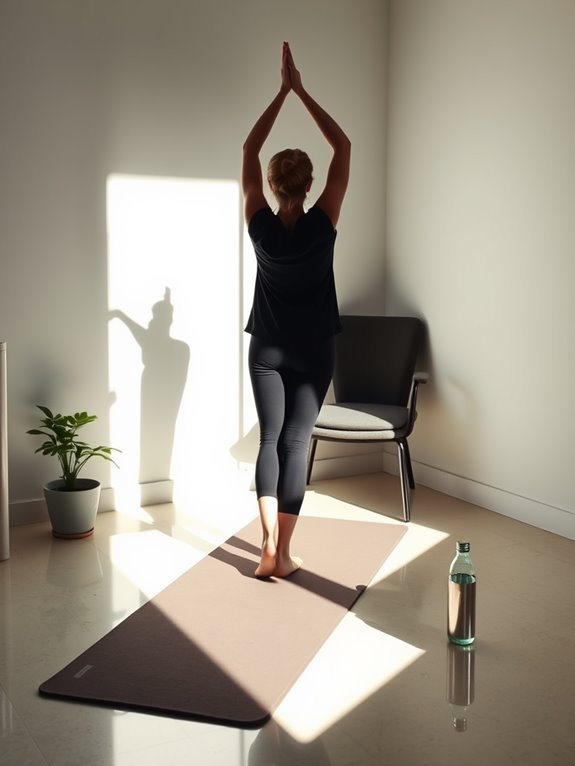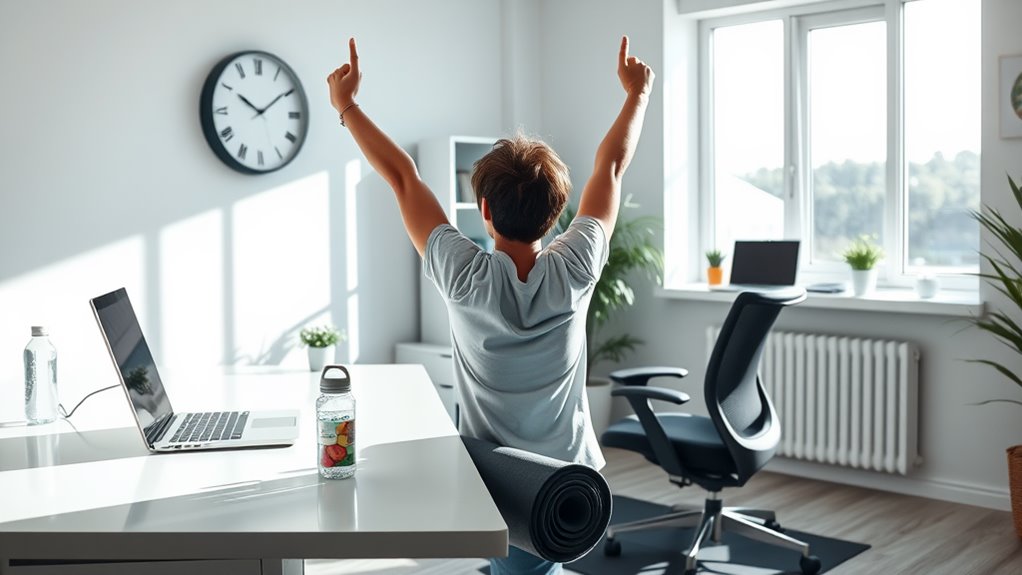To take effective ergonomic breaks and prevent fatigue, recognize signs like discomfort or muscle tension as cues for rest. Incorporate simple movements, like quick walks, and practice stretches targeting your wrists, neck, and hips. Stay hydrated to maintain energy, and engage in mindfulness exercises such as deep breathing. Establish a structured break schedule, using techniques like the Pomodoro Technique, to enhance focus. Continue exploring additional strategies for optimizing your breaks and improving overall well-being.
Nomad Highlights
- Recognize signs of discomfort, such as eye strain or muscle tension, as cues to take regular breaks for improved well-being.
- Incorporate simple movements and stretches during breaks to target muscles affected by prolonged sitting, enhancing circulation and flexibility.
- Stay hydrated throughout the day to maintain energy levels and cognitive function, using clean water sources and eco-friendly containers.
- Implement a structured break schedule, like the Pomodoro Technique, to balance focused work with short, restorative breaks.
- Practice mindfulness techniques, such as deep breathing and journaling, to reduce stress and improve mental clarity during breaks.
Understanding Ergonomics and Its Importance

Although many people underestimate its significance, understanding ergonomics is crucial for maintaining health and productivity in the workplace. Ergonomic principles focus on optimizing your workplace setup to enhance comfort and efficiency. By applying these principles, you can reduce the risk of musculoskeletal disorders and improve overall well-being. Incorporating adjustable height options in your workspace can further enhance comfort during extended use. For instance, using an ergonomic adjustable footrest can significantly improve your posture and promote better circulation.
Start by adjusting your chair height to guarantee your feet rest flat on the floor, and position your monitor at eye level to minimize neck strain. Utilizing ergonomic chairs can provide comprehensive support for your head, back, hips, and arms, which is essential for long hours of sitting. Utilize a keyboard and mouse that promote natural wrist positioning. Additionally, incorporating unique products for your lifestyle can transform your workspace into a more ergonomic environment.
Additionally, incorporating adjustable furniture allows for a customizable workspace that adapts to your needs. Prioritizing ergonomic design not only fosters innovation but enhances focus, creativity, and long-term productivity. Investing in ergonomic monitor mounts can further support your posture and reduce strain during extended work hours.
Signs You Need an Ergonomic Break

When you start feeling discomfort or fatigue during your workday, it’s a clear signal that you need an ergonomic break. Recognizing fatigue symptoms like eye strain, muscle tension, or headaches is essential for maintaining productivity. Incorporating tools like handheld massagers can further help relieve muscle tension and promote relaxation during these breaks, as they offer targeted muscle relief for various tension points. Additionally, keeping a portable hand sanitizer handy can help maintain hygiene, especially if you’re taking breaks in public spaces. Engaging in hobbies during these breaks can also enhance your mental well-being and creativity, making them beneficial for overall health. Regular use of tools like acupressure mats can also enhance relaxation and pain management, leading to improved overall wellness.
If you notice these signs, it’s time to assess your break duration; a short, well-timed pause can meaningfully enhance your performance. Ideally, aim for a break every hour, lasting at least five to ten minutes, allowing your body and mind to reset. Ignoring these signals can lead to decreased efficiency and long-term health issues. Stay attuned to your body’s cues; proactive breaks can prevent fatigue from escalating and support your overall well-being while fostering a more innovative and energetic work environment.
Simple Movements to Incorporate During Breaks

Incorporating simple movements during your breaks can greatly enhance your physical well-being and productivity. Start by integrating quick walks around your workspace. This boosts circulation and energizes your body, reducing fatigue. Aim for five-minute walks every hour to reset your focus. Additionally, consider simple stretches that target key muscle groups affected by prolonged sitting. Arm raises, neck rolls, and wrist stretches can alleviate tension and improve flexibility. These movements not only foster physical relief but also stimulate mental clarity. Incorporating resistance bands into your routine can further enhance your workouts and prevent fatigue during extended periods of sitting. Using stretching straps can also improve your flexibility and recovery, making your breaks even more effective. Furthermore, using natural latex bands can provide adjustable resistance, enabling you to customize your workouts based on your fitness level and goals. Consider selecting bands that offer multiple resistance levels to ensure you can progress as you build strength. Additionally, utilizing adjustable dumbbells in conjunction with your workouts can enhance versatility and target various muscle groups effectively.
Stretching Techniques for Desk Workers

Taking regular breaks to move around is beneficial, but adding specific stretching techniques can further alleviate the physical strain of desk work.
Incorporate desk stretches like wrist flexors to combat tension from typing. For neck releases, gently tilt your head side to side, easing upper back stiffness. Perform shoulder rolls to improve circulation and reduce tightness. Using a compact foam roller after these stretches can further enhance muscle recovery and relieve tension effectively. Additionally, incorporating ankle resistance bands can help strengthen lower leg muscles, which is important for overall stability. Stretching straps can also provide enhanced flexibility and support during your stretching routine. To further support your balance and coordination, consider integrating portable balance boards into your exercise routine.
Include hamstring stretches by standing and reaching for your toes. Seated twists can enhance spinal mobility, while calf stretches promote lower leg flexibility.
Don’t forget hip openers; they relieve tightness from prolonged sitting. Finger stretches are essential for reducing strain in your hands. Additionally, using compact foam rollers can enhance muscle recovery and relieve tension effectively after your stretches.
The Role of Hydration in Maintaining Energy

Staying properly hydrated is essential for maintaining energy levels during long hours at a desk. Dehydration can lead to fatigue, decreased concentration, and impaired cognitive function. Additionally, using a water bottle with a filtration system can ensure you have access to clean water, enhancing your hydration efforts while you work. Portable water purifiers, such as advanced filtration systems, can effectively remove harmful microorganisms, giving you peace of mind about the water you consume. For instance, purifiers like the Sawyer Products SP128 Mini Water Filtration System can remove 99.99999% of bacteria, ensuring high water quality. Moreover, regularly using eco-friendly materials for your water bottles can help reduce plastic waste.
By prioritizing hydration, you’ll experience significant hydration benefits that help sustain your productivity. Aim to drink water consistently throughout your workday, rather than waiting until you’re thirsty. Research suggests that even mild dehydration can negatively impact your energy levels. Consider incorporating smart technologies, like a hydration tracking app, to remind you to take breaks and drink water regularly. Additionally, enhance your hydration by consuming water-rich foods, such as fruits and vegetables, which can further boost your energy. Regularly using a reusable water bottle can also encourage you to drink more water throughout the day.
Mindfulness and Breathing Exercises

Incorporating mindfulness and breathing exercises into your breaks can greatly enhance your focus and reduce stress. You’ll find that deep breathing techniques help regulate your heart rate and calm your mind, while mindful movement practices promote physical well-being. Together, these methods create a balanced approach to maintaining productivity and mental clarity throughout your workday. To further support your well-being, consider using biofeedback devices that track physiological responses and help manage stress effectively. Additionally, taking short breaks to use an acupressure mat can provide significant pain relief and relaxation, enhancing your overall work experience. Journals that encourage self-reflection can also be beneficial in developing a consistent mindfulness routine, while incorporating essential oil blends can enhance relaxation and improve your focus during breaks. Engaging with real-time feedback from biofeedback devices can deepen your understanding of how your body responds to stress and mindfulness practices.
Deep Breathing Techniques
How can deep breathing techniques enhance your overall well-being during work? By incorporating deep breathing into your routine, you activate your body’s relaxation response, reducing stress and increasing focus. These relaxation techniques encourage oxygen flow, which can enhance cognitive function and productivity. Additionally, using mindfulness card decks can provide structured practices that complement your deep breathing exercises. Research shows that herbal teas can also promote relaxation and improve sleep quality, making them a great addition to your wellness routine. Furthermore, utilizing essential oils can further elevate your relaxation experience, creating a calming atmosphere conducive to deep breathing.
To practice, find a quiet space, close your eyes, and inhale deeply through your nose for a count of four. Hold for four counts, then exhale slowly through your mouth for another four. Research indicates that emotional intelligence can significantly improve workplace dynamics, which may further motivate your commitment to these practices.
Repeat this cycle several times. This method not only calms your mind but also alleviates physical tension, making it an innovative solution for combating work-related fatigue. Integrating deep breathing into your breaks can notably elevate your performance and overall job satisfaction. Moreover, engaging with breathwork techniques can lead to deeper self-awareness and emotional clarity, further enhancing your well-being during work.
Mindful Movement Practices
While you may be focused on completing tasks, integrating mindful movement practices into your routine can greatly enhance your physical and mental well-being.
Engaging in mindful walking encourages body awareness, allowing you to connect with your environment and your physical state. As you walk, concentrate on each step, noticing the sensations in your feet and legs, and breathing deeply to promote relaxation. This practice not only alleviates stress but also improves posture and circulation.
Additionally, incorporate brief stretching sessions that emphasize awareness of your body’s movements and tension areas. These techniques foster a holistic approach to ergonomics, ultimately preventing fatigue and enhancing productivity.
Embrace these mindful practices to innovate your daily routine and elevate your overall performance.
Creating a Break Schedule for Maximum Efficiency

To maximize efficiency during your workday, you need to create a structured break schedule.
Determine how often you should take breaks, incorporate stretching exercises to alleviate tension, and set timers as reminders.
These steps will help you maintain focus and reduce fatigue throughout your tasks.
Determine Optimal Break Frequency
Establishing an effective break schedule is essential for maintaining productivity and reducing fatigue during long work periods.
To determine your ideal break frequency, consider your task variety and break duration. Research suggests that taking short breaks every 60 to 90 minutes enhances focus and performance. For instance, a 5- to 10-minute break allows your mind to recharge without losing momentum.
During these breaks, switch tasks or engage in a quick, enjoyable activity to stimulate your brain differently. This not only prevents monotony but also keeps your energy levels elevated.
Incorporate Stretching Exercises
Integrating stretching exercises into your break schedule can greatly enhance the benefits of those short pauses. Incorporate dynamic stretches before you resume work to boost circulation and flexibility. These movements, like arm circles and torso twists, invigorate your muscles and improve range of motion.
Alternatively, seated stretches can be performed if you’re short on time or space. Simple neck rolls and wrist stretches can alleviate tension accumulated during prolonged sitting. Aim for a variety of stretches to target different muscle groups, enhancing overall body awareness and reducing the risk of fatigue.
Use Timers for Reminders
While you may intend to take breaks regularly, it’s easy to lose track of time amidst your workload. To combat this, utilize timer apps that can help you create an effective break schedule.
Set reminder intervals that align with your work patterns—consider 25 minutes of focused activity followed by a 5-minute break, known as the Pomodoro Technique. These intervals not only enhance productivity but also prevent fatigue by ensuring you step away from your screen.
Timer apps can provide customizable alerts, allowing you to adjust intervals based on your personal preferences or tasks. By implementing this structured approach, you’ll optimize your work efficiency and maintain your energy levels throughout the day.
Frequently Asked Questions
How Often Should I Take Ergonomic Breaks During My Workday?
You should aim to take ergonomic breaks every 30 to 60 minutes during your workday.
This break frequency maximizes your productivity while minimizing fatigue. Each break should ideally last for 5 to 10 minutes, allowing you to stretch, move, or rest your eyes.
By adhering to this ideal duration, you’ll enhance your comfort and maintain focus, fostering a more innovative and efficient work environment.
Prioritize these breaks for better long-term performance.
Can Ergonomic Breaks Improve My Overall Productivity?
Oh sure, who needs breaks, right? Just power through your workday like a robot!
But wait—those ergonomic breaks aren’t just for fun; they offer real ergonomic benefits. By stepping away from your screen, you’ll experience a productivity boost that’s hard to ignore.
Regular breaks help reduce fatigue and enhance focus, allowing you to tackle tasks with renewed energy.
What Should I Do if I Forget to Take Breaks?
If you forget to take breaks, set reminder alarms on your devices to prompt you at regular intervals.
Incorporate visual cues in your workspace, like sticky notes or an eye-catching timer, to serve as constant reminders.
By actively engaging these tools, you enhance your awareness of time and encourage movement.
This proactive approach not only helps prevent fatigue but also boosts your focus and overall productivity throughout the day.
Are There Specific Exercises for Remote Workers?
Are you ready to transform your remote work experience into a zen-like paradise?
You’ve got to try specific exercises tailored just for you! Incorporate stretching routines that elongate those stiff muscles and posture exercises that reinforce a strong spine.
Take a few moments each hour to engage in these movements, and watch fatigue vanish like magic!
With dedication, you’ll boost your productivity and feel invigorated, ready to tackle any challenge that comes your way.
How Can I Encourage My Coworkers to Take Breaks?
To encourage your coworkers to take breaks, implement regular break reminders using digital tools or apps.
Suggest organizing group activities during these breaks, like quick stretching sessions or team walks, to foster a sense of community.
By creating a culture that values these pauses, you’ll enhance overall productivity and well-being.
Share the benefits of breaks in team meetings, highlighting how they boost focus and creativity, making it easier for everyone to participate.
Conclusion
Incorporating ergonomic breaks into your daily routine is like tuning a musical instrument; without it, your performance suffers. Just as a musician must pause to adjust their strings, you need these breaks to reset and recharge. By recognizing the signs of fatigue and implementing simple movements, you’ll maintain your focus and energy throughout the day. So, prioritize your well-being with a structured break schedule, and watch your productivity hit a high note.




